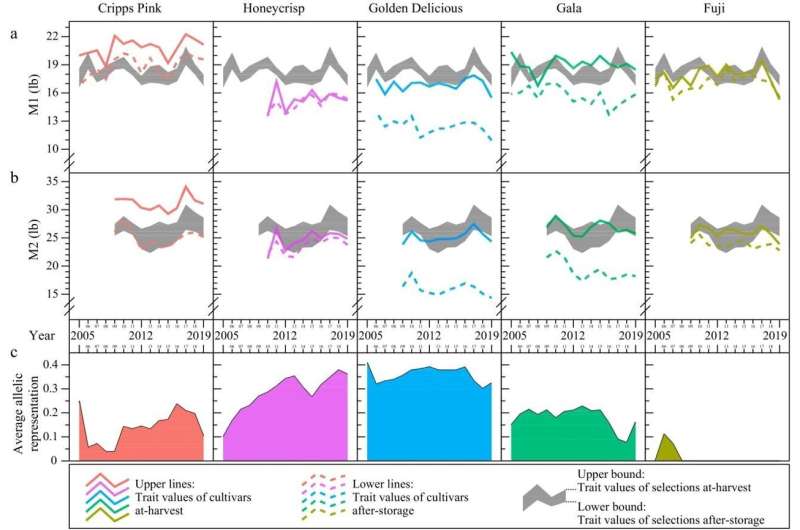This article has been reviewed according to Science X's editorial process and policies. Editors have highlighted the following attributes while ensuring the content's credibility:
fact-checked
proofread
Multi-year trends in apple firmness retention post-storage and cultivar influence on breeding selections

A research team at Washington State University has demonstrated considerable advancement in enhancing apple firmness and its retention during cold storage, which is vital for fruit quality. The study analyzed 15 years worth of data from, from 2005 to 2019, emphasizing increased inner cortex firmness, which was influenced by cultivars like "Cripps Pink" and "Honeycrisp."
This research underscores the value of genetic selection in breeding programs, potentially leading to apples with superior storability, which aligns with the program's goal of improved fruit quality during cold storage.
The trend analysis of breeding records revealed that the Washington State University apple breeding program (WABP) has been focusing on the selection of apples with improved eating quality and storability. Current research predominantly measures outer cortex firmness, with relatively limited attention paid to inner cortex firmness.
The study, published in Fruit Research on 2 July 2024, aims to address the gap by focusing on after-storage retention of inner cortex fruit firmness, examining the genetic contributions of key cultivars, and assessing the WABP's overall progress in breeding for improved fruit storability.
The phenotypic distribution of maximum hardness in R1 (termed M1) and maximum hardness in R2 (termed M2) values for both "at-harvest" and "after storage" samples over multiple years was analyzed using penetrometers to measure outer and inner cortex firmness. For M1 measurements, most "at-harvest" (H) samples ranged between 16 and 22 lbs, with higher variance in certain years. "After-storage" (S) samples showed reduced firmness.
M2 measurements followed similar trends, with "H" values typically between 24 and 31 lbs and "S" values consistently lower. The data revealed that M1 and M2 firmness values were generally highest for "H" selections, followed by "H" cultivars, "S" selections, and "S" cultivars. Notably, selections exhibited better after-storage firmness retention in comparison to cultivars. Year-to-year analysis showed smaller deltas in firmness loss for selections than for cultivars.
Additionally, the average allelic representation (AAR) indicated increasing genetic contributions from "Honeycrisp" and "Cripps Pink," while "Golden Delicious" remained consistently represented. This study highlights the effectiveness of the WABP in selecting apples with enhanced firmness and storability, emphasizing the genetic influence of key cultivars on these traits.
According to the study's lead researcher, Kate Evans, "This 15-year trend analysis showed that the WABP has been selected for increased fruit firmness (particularly of the inner cortex), and retention of inner cortex firmness among the P2 selections. This breeding progress also aligns with one of the three WABP's overarching objectives—improved fruit storability."
In summary, the WABP resulted in enhanced apple firmness and storability over a 15-year period, as evidenced by data collected from 2005 to 2019. The study revealed that the selected cultivars exhibited superior and more sustained firmness, particularly in the inner cortex, influenced by "Cripps Pink" and "Honeycrisp." Future efforts will focus on breeding strategies and leverage genetic insights to further elevate apple quality and align with consumer demands.
More information: Soon Li Teh et al, Multi-year trends of retention of fruit firmness after storage and influence of cultivar representation among apple breeding selections, Fruit Research (2024). DOI: 10.48130/frures-0024-0020
Provided by TranSpread


















